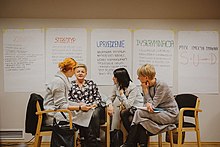Discrimination Facts for Kids
Discrimination is the unfair treatment of individuals based on characteristics like race, gender, age, or religion.
View Article For:

Related Articles
Introduction
Discrimination can happen in many places like schools, jobs, or even in our neighborhoods. It's important to recognize that everyone deserves kindness and respect, no matter their differences. In many countries, there are laws to help protect people from discrimination. Learning about this topic helps us build a better world where everyone can feel safe and happy! 😊
Types Of Discrimination
️🌈 Gender discrimination happens when people are treated differently because they are boys or girls. Age discrimination occurs when someone is treated unfairly due to how old they are—like an adult not trusting a teenager! Elderly people sometimes face this too. There’s also discrimination based on religion, sexuality, or disabilities. Every type is unfair and hurtful. 💔
That's why we need to treat everyone with love and respect, no matter who they are!
Discrimination In Education
Some students might not be treated fairly because of their background, which makes school a hard place. For example, some kids may not receive support if teachers are biased or if there are fewer resources for certain communities. This can lead to lower grades and missed opportunities! 🙁
Many countries have laws to protect students from discrimination, ensuring that every child can learn and succeed. It’s vital for schools to promote equality and support every student, creating a welcoming environment where everyone can shine! 🌟
Social Movements And Advocacy
One famous movement is the Civil Rights Movement in the 1960s, led by heroes like Martin Luther King Jr. He fought for equal rights for African Americans and inspired many people! Similarly, the Women's Rights Movement sought equality for women, championing leaders like Malala Yousafzai today. 🌟
People also advocate for LGBTQ+ rights, promoting acceptance for everyone, regardless of who they love. These movements teach us that standing up for what is right can lead to greater fairness and kindness in the world! 🌍✊
Discrimination In The Workplace
This is called employment discrimination. For example, women often faced difficulties getting the same pay as men even for the same job! ⚖
️ It's illegal in many places to treat someone unfairly because of who they are. Companies are encouraged to create inclusive environments so that everyone feels valued and respected. Steps like diversity training can help everyone understand how to be better co-workers and friends, making the workspace a happier place! 😊
Intersectionality In Discrimination
This makes it important to recognize that discrimination can affect people in many ways at the same time. Everyone’s experiences are different! When we understand intersectionality, we can show more empathy and support. 💖
This helps us to stand up against all types of discrimination and creates a stronger community by valuing every individual’s journey and story! 🌈
Historical Context Of Discrimination
This meant they couldn't share schools or restaurants with white people. Another example is when women didn't have the same rights as men, especially in the 19th century! 👩
🎓 People fought hard, like Rosa Parks and Susan B. Anthony, to change these unfair rules. By learning history, we understand why fighting against discrimination is so important!
Global Perspectives On Discrimination
In India, caste discrimination can still impact people's opportunities, especially for those in lower castes. In Myanmar, the Rohingya people face harsh treatment and exclusion. 😓
In Europe, refugees may experience discrimination due to their backgrounds. But around the world, many groups are fighting against these inequalities! ✊
Learning about global perspectives helps us see the bigger picture of discrimination and encourages us to stand together, no matter where we live. By understanding differences, we can work hand in hand for a better future for everyone! 🌟
Legal Frameworks Against Discrimination
For example, in the United States, there are important laws like the Civil Rights Act of 1964, which helps end racial discrimination. Laws in other countries, like the Equality Act in the United Kingdom, also protect people regardless of their race, gender, or disability. 🏛
️ Legal frameworks make it illegal to treat someone unfairly! Courts can help victims seek justice. These laws are in place to help everyone feel safe and protected in everyday life, ensuring we can all participate equally in society.
Strategies For Combatting Discrimination
Sharing knowledge helps break down stereotypes. Secondly, we can speak up when we see discrimination happening, whether in our schools or communities. 🗣
️ Supporting organizations that work against discrimination can also make a big difference! Volunteering or donating helps raise awareness. Additionally, we can encourage friendships among people from different backgrounds, celebrating uniqueness! 🤝
Small actions, like being kind and standing up for others, can create a ripple effect of love and acceptance, making the world better for everyone! 🌈
Effects Of Discrimination On Individuals And Communities
For instance, children who experience bullying because of their differences may struggle to make friends. This is not good for them or their community! Discrimination also creates divisions, making it harder for people to work together. 🏘
️ When everyone feels included, communities are happier and stronger. We can all help reduce discrimination by being kind and supporting each other. When we work together, we can create a world where everyone celebrates differences instead of fearing them! 🌈
DIY is a humongous library of
activities and courses for kids.
Curious?
Gallery of

Did you know?
🌍 Discrimination means treating people unfairly because of their race, gender, or religion.
🚫 Discrimination has a long history, with examples like slavery and segregation.
🏳️🌈 Racial discrimination is when someone is treated unfairly because of their skin color.
💔 Gender discrimination occurs when people are treated differently because they are boys or girls.
😢 Discrimination can make people feel sad, alone, or scared.
🏘️ Inclusive communities are stronger and happier when everyone feels included.
📜 Laws exist to protect people from unfair treatment based on their differences.
🚀 Social movements like the Civil Rights Movement work to create change and fight discrimination.
💼 Employment discrimination can prevent people from getting jobs just because of who they are.
🌈 Recognizing intersectionality helps us understand the unique experiences of people facing multiple types of discrimination.


